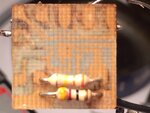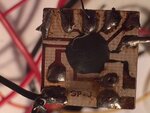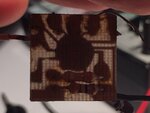Eyeopr8r
Newbie level 5
Hi,





 new to forum and not an electronics genius. I need to identify and replace this chip if possible. It's from a family heirloom plastic winky-blinky bow tie my mother bought for me some 25-30 years ago. Ive worn it everyday at work from thanksgiving day until Christmas for about 30 years. This chip makes 10 LEDs on the surface of the bow tie blink randomly. I've managed over these many years to keep it working with various Rube-Goldberg-type repairs, but now either I don't know which wires to solder where on the chip, or the chip is shot. Someone please show pity and help. Ive scoured the internet for hours to replace the actual bow tie itself but they just are no longer made or a available. Thanks
new to forum and not an electronics genius. I need to identify and replace this chip if possible. It's from a family heirloom plastic winky-blinky bow tie my mother bought for me some 25-30 years ago. Ive worn it everyday at work from thanksgiving day until Christmas for about 30 years. This chip makes 10 LEDs on the surface of the bow tie blink randomly. I've managed over these many years to keep it working with various Rube-Goldberg-type repairs, but now either I don't know which wires to solder where on the chip, or the chip is shot. Someone please show pity and help. Ive scoured the internet for hours to replace the actual bow tie itself but they just are no longer made or a available. Thanks





 new to forum and not an electronics genius. I need to identify and replace this chip if possible. It's from a family heirloom plastic winky-blinky bow tie my mother bought for me some 25-30 years ago. Ive worn it everyday at work from thanksgiving day until Christmas for about 30 years. This chip makes 10 LEDs on the surface of the bow tie blink randomly. I've managed over these many years to keep it working with various Rube-Goldberg-type repairs, but now either I don't know which wires to solder where on the chip, or the chip is shot. Someone please show pity and help. Ive scoured the internet for hours to replace the actual bow tie itself but they just are no longer made or a available. Thanks
new to forum and not an electronics genius. I need to identify and replace this chip if possible. It's from a family heirloom plastic winky-blinky bow tie my mother bought for me some 25-30 years ago. Ive worn it everyday at work from thanksgiving day until Christmas for about 30 years. This chip makes 10 LEDs on the surface of the bow tie blink randomly. I've managed over these many years to keep it working with various Rube-Goldberg-type repairs, but now either I don't know which wires to solder where on the chip, or the chip is shot. Someone please show pity and help. Ive scoured the internet for hours to replace the actual bow tie itself but they just are no longer made or a available. Thanks

